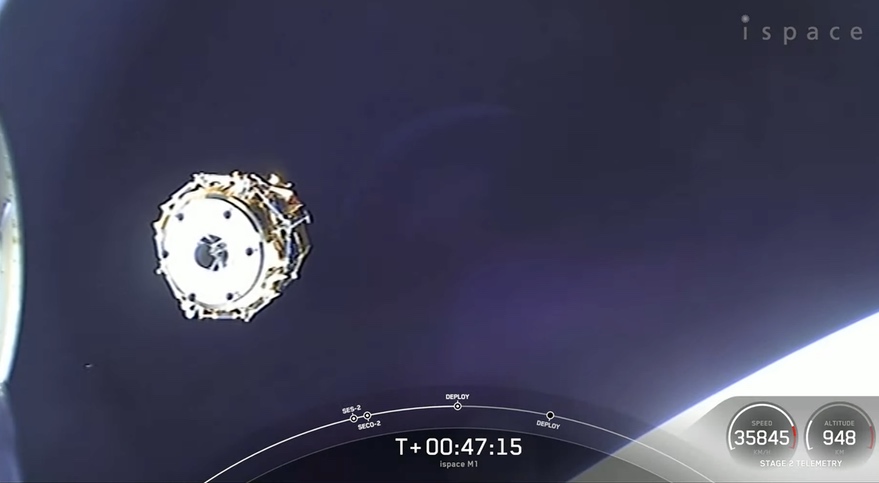
Falcon 9 launches ispace lander and NASA cubesat to the moon (Image Credit: Space News)
WASHINGTON — A new era of commercial lunar missions started Dec. 11 with the Falcon 9 launch of a Japanese lander mission that also carried a NASA cubesat.
The SpaceX Falcon 9 lifted off from Cape Canaveral’s Space Launch Complex 40 at 2:38 a.m. Eastern. The rocket’s first stage, making its fifth flight, landed at the company’s Landing Zone 1 at Cape Canaveral about eight minutes after liftoff.
The launch, previously scheduled for late November, slipped by nearly two weeks because of unspecified issues with the Falcon 9. The previous Falcon 9 launch, of 40 OneWeb satellites Dec. 8, also suffered delays, although it’s unclear if they are related.
The rocket’s second stage, after a second burn, deployed the HAKUTO-R M1 spacecraft for Japanese company ispace 47 minutes after liftoff. The spacecraft will fly a low-energy trajectory to the moon that will set the spacecraft up for a landing in about five months.
HAKUTO-R M1 will attempt a soft landing in Atlas Crater, located on the edge of Mare Frigoris in the northeastern quadrant of the near side of the moon. Tokyo-based ispace considers HAKUTO-R M1 primarily a test flight of the spacecraft with several technology demonstration and promotional payloads on board, including the Rashid lunar rover from the United Arab Emirates. A second lander mission, M2, is scheduled for launch no earlier than 2024.
HAKUTO-R started 12 years ago as a team in the Google Lunar X Prize, a competition by the X Prize Foundation to stimulate development of commercial lunar landers. “At the time of the X Prize, I thought that we could launch three to five years after we started,” recalled Takeshi Hakamada, founder and chief executive of ispace, in a pre-launch interview. “However, it was probably necessary to spend this amount of time.”
Only the United States, China and the former Soviet Union have successfully soft-landed on the moon. In 2019, Beresheet, a privately funded Israeli spacecraft, crashed attempting to land on the moon, followed several months later by the failed landing of the Chandrayaan-2 spacecraft by India’s space agency ISRO.
“From the design point of view, we did everything that we could do” to ensure a successful landing, Hakamada said, including external reviews of the spacecraft. “We have high confidence on the landing.”
That confidence comes in part, he said, from working with Draper, which provided guidance, navigation and control software. “When other spacecraft have failed in the past, it’s always been in the landing phase. Working with Draper, that gives us high confidence on landing.”
“It’s not easy, but it’s feasible,” he said. “We’ve done everything we can do.”
Hakamada said work is already underway on ispace’s M2 lander, which will be similar to M1. “We have several improvements” for that lander based on the development of M1. “We can make sure we have a better mission for mission 2.”
The launch of HAKUTO-R M1 marks the start of a new wave of commercial lunar missions. Two U.S. companies, Astrobotic and Intuitive Machines, are planning launches of their first lunar landers in early 2023. Both companies are carrying payloads for NASA’s Commercial Lunar Payload Services (CLPS) program and for other government and commercial customers.
Draper and Firefly also have CLPS awards for commercial lunar lander missions. The Draper mission will use a lander developed by ispace’s U.S. office significantly larger than the HAKUTO-R landers.
“We’re opening a new era of the commercial space industry,” Hakamada said.
Also on the launch was Lunar Flashlight, a cubesat developed by NASA’s Jet Propulsion Laboratory, that separated from the Falcon 9 upper stage about six minutes after HAKUTO-R M1. The 6U cubesat will go into a highly elliptical orbit that will take it within 15 kilometers of the surface over the south pole, allowing it shine lasers into the craters there to look for evidence of water ice.
Lunar Flashlight was originally slated to go on the inaugural launch of the Space Launch System. However, problems with the spacecraft’s propulsion system caused it to miss a delivery deadline in the fall of 2021 to be integrated on the rocket. NASA originally procured a flight for it as a secondary payload on the Intuitive Machines IM-1 mission, then moved it to the ispace launch when the IM-1 mission slipped from late 2022 to March 2023.








